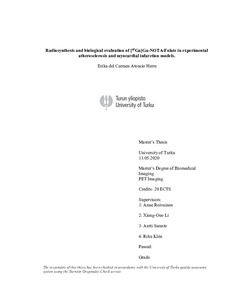Radiosynthesis and biological evaluation of [68Ga]Ga-NOTA-Folate in experimental atherosclerosis and myocardial infarction models.
Atencio Herre, Erika (2020-05-12)
Radiosynthesis and biological evaluation of [68Ga]Ga-NOTA-Folate in experimental atherosclerosis and myocardial infarction models.
Atencio Herre, Erika
(12.05.2020)
Julkaisu on tekijänoikeussäännösten alainen. Teosta voi lukea ja tulostaa henkilökohtaista käyttöä varten. Käyttö kaupallisiin tarkoituksiin on kielletty.
avoin
Julkaisun pysyvä osoite on:
https://urn.fi/URN:NBN:fi-fe2020061744821
https://urn.fi/URN:NBN:fi-fe2020061744821
Tiivistelmä
While many folate-receptor (FR) targeting radiotracers have been studied for imaging cancers, there is a need for tracers that target inflammation for diagnostic and monitoring purposes. Two diseases in which inflammation plays a key role are atherosclerosis and myocardial infarction (MI). Inflammation is critical to the development and progression of atherosclerosis, which can lead to MI. Higher macrophage levels have been associated with adverse remodeling effects in post-MI healing. Given the commonality of these potentially fatal conditions, it is of great interest to have a reliable radiotracer available for non-invasive detection and monitoring. As FR-β expression is upregulated in active macrophages, it serves as a great target for imaging of inflammation. [68Ga]Ga-NOTA-Folate, a new FR-targeting radiotracer, was synthesized and biologically evaluated to assess its ability to target inflammation in mouse and human atherosclerotic lesions. Mice were studied using in vivo positron emission tomography and ex vivo digital autoradiography of aorta sections. Human carotid artery tissues were studied in vitro for tracer binding. In addition, rat heart tissue sections were incubated in vitro with [68Ga]Ga-NOTA-Folate to evaluate post-MI healing. Upon analyzing the in vitro binding, [68Ga]Ga-NOTA-Folate showed significantly higher binding in atherosclerotic lesions when compared to tissues treated with folate glucosamine, a FR blocker, indicating specificity of [68Ga]Ga-NOTA-Folate via FRs. As the atherosclerotic lesions observed in the experimental mice were not so extensive, more in vivo studies should be done to verify the results.
